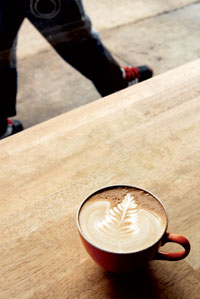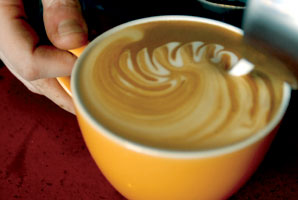While art can take many forms, there is something extra special about art you can eat. The baristas at Colter Coffee Roasting have taken this theory to heart. They can whip up not only a custom drink, but also one with a special design on the top.
It’s called latte art, and it can take plenty of practice to master, as Colter Coffee Manager Heather Anderson will tell you. It takes her only seconds to create a perfect rosetta – a kind of leafy design – on a latte these days, but it comes after years of practice and attention to detail.
The most common designs are rosettas, hearts or a combination of both, all of which Anderson expects to see at the upcoming Latte Art Competition at Colter Coffee Roasting on March 14.
This is the second year for the competition, which attracted eight competitors from all over the valley last year and is expected to have more this year.
Latte art is aesthetically pleasing, but there is also a pragmatic reason to swirl the white foam with the rich, dark espresso. Colter Coffee Owner Lindsay MacDonald made latte art a standard for his shops because he thinks it produces the best possible mixture of all the ingredients.
“It’s a creamier texture and makes the espresso sweeter,” MacDonald said during a visit to his shop on Main Street. “It’s not a layered drink; it’s all one mass.”
Before a barista can even begin to learn the swirls and flips of the wrist it takes to make a rosetta or a heart in the foam, they must learn the proper way to make the foam itself. Good latte art can only be made with properly aerated milk, which can be difficult to master at first, MacDonald said.
The process begins with steaming the milk, which introduces air and heat in the liquid. Well-steamed milk should be luxurious and velvety, Anderson said, not bubbly. This makes latte art more difficult with thinner liquids, such as skim milk and soymilk.
 |
|
A Rosetta pattern is seen folded across the surface of a latte at Colter Coffee Roasting in Kalispell. Colter Coffee is hosting a free pour latte art competition on March 14. |
But these baristas are up for the challenge, regardless of liquid viscosity. Working at Colter Coffee means mandatory designs in every cup, whether it’s take-out or dine-in service.
The competition on March 14 is designed to show the community what the baristas can do, but also to spread the practice to other coffee places around the valley, MacDonald said.
And since the Colter Coffee employees have such a practiced hand, they will have their own internal competition while other participants will compete against each other. This levels the field in a couple ways; outside baristas would not be as familiar with the espresso machines used at the Colter shops and they may be nervous to compete against veteran foam artists.
“We want to encourage people to learn how to do it,” MacDonald said.
There will be prizes for the first-, second- and third-place competitors. First place gets an iPod touch music player; second place gets an iPod nano and third place earns gift certificates from local businesses.
The coffee shop that employs the winning barista will also receive 25 pounds of Colter Coffee.
Many believe latte art competitions were first brewed up in Seattle, where they have and still continue to draw huge crowds and competition from all over the country. Some contestants have produced cartoon monkeys, dogs and faces in the foam.
Latte art can be created by pulling a toothpick through the foam to draw out the creation, but the Colter Coffee competition will be free pour only, meaning competitors are only allowed to pour milk into the espresso to make the design.
The public is welcome to attend the event and even participate if they are feeling up to the challenge. MacDonald said he expects to have a judge from another coffee company involved as well.
 |
|
Heather Anders begins creating a curved Rosetta pattern across the surface of a latte to demonstrate the process of latte art at Colter Coffee Roasting in Kalispell. |
Competitors will have five minutes to figure out the machine and grinder, followed by five minutes to pour as many lattes as possible. The contestant may then pick one of the lattes for judging.
There will be a $10 cover charge at the door and, since the espresso machines will be busy whirring out artful ingredients, only drip coffee will be available after 4:30 p.m. The $10 covers the cost of the latte art class from 4:30 p.m. to 5 p.m., refreshments and a decorative latte.
The competition runs from 5 p.m. to 6:30 p.m. It should be good-natured fun for everyone, whether they are furiously whipping up caffeine creations or just enjoying the show, Anderson said.
“It’s fun for our customers and it is great for the valley,” Anderson said.
The Latte Art Competition takes place on March 14 at 4 p.m. at Colter Coffee Roasting, 338 Main Street, Kalispell.